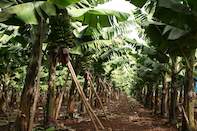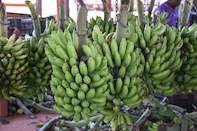
Yield (tonnes per hectare)
Conservative: 20 tonnes
Average: 40 tonnes
Good: 60 tonnes+
Harvesting

Harvesting bananas is done by hand and most bananas are harvested at optimum size, but still green, so that transportation is easier and are then ripened in ripening rooms or chambers in the marketplaces and sold immediately thereafter.
The stage at which the bananas are harvested depends on the distance and shipping time to market. These times are determined by the marketing agent requirement and agronomist consultation.
Most bananas are packed in cartons by separating the hands from the bunch. The cartons are shipped in containers or bulk ships.
Storage
Storage of green bananas to slow the ripening process is best at about 14°C and a relative humidity of 90%. During the period of ripening the temperature is lifted to between 16°C and 18°C and a relative humidity of 95% is best. Ethylene gas is used in the ripening chambers to hasten ripening and even colouring of the bananas.
Pests
Rodents are a big problem and can cause a lot of damage specially to ripening fruit.
Common insect pests are Aphids, Bud moths, Fruit caterpillar, Fruit fly, Nematodes, Weevils, Spider mite, Thrips.
Diseases
Anthracnose, Crown rot and Cigar end rot, Leaf rust, Mosaic Virus, Panama Disease TR4, Rhizome rot and Sigatoka.
There are many other pests and diseases and some more prevalent in certain production areas than others, so it is best to consult a local specialist and follow a strict crop protection program to safeguard your orchards and crop.